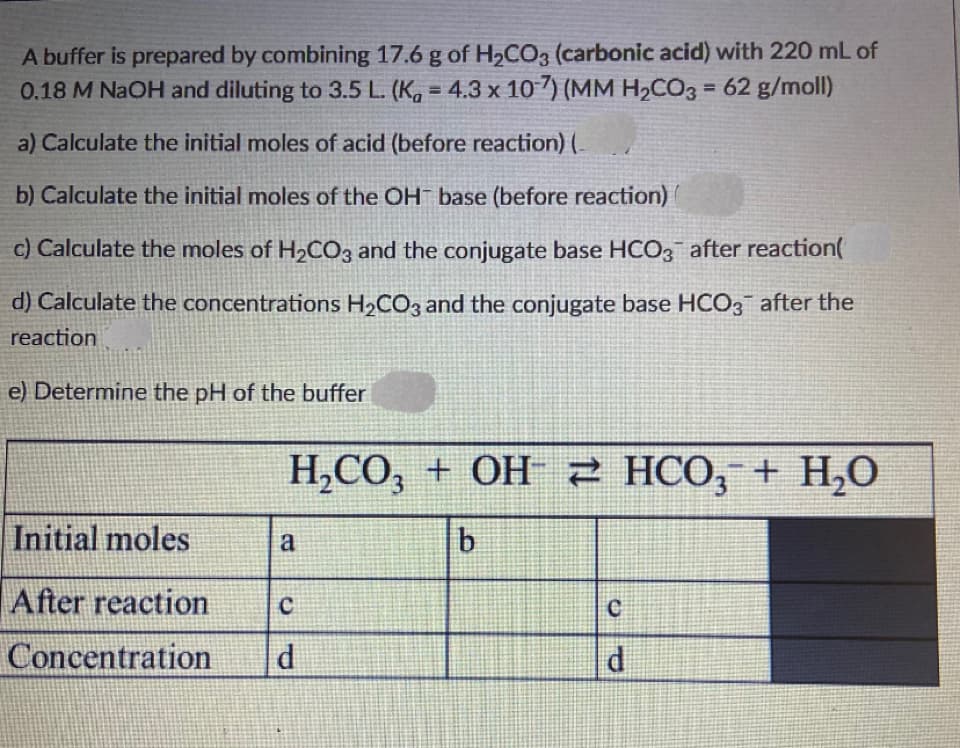A buffer is prepared by combining 17.6 g of H2CO3 (carbonic acid) with 220 mL of 0.18 M NAOH and diluting to 3.5 L. (K, = 4.3 x 107) (MM H2CO3 = 62 g/moll) %3D a) Calculate the initial moles of acid (before reaction) (. b) Calculate the initial moles of the OH base (before reaction) c) Calculate the moles of H2CO3 and the conjugate base HCO3 after reaction( d) Calculate the concentrations H2CO3 and the conjugate base HC03 after the reaction e) Determine the pH of the buffer H,CO, + OH 2 HCO, + H,0 Initial moles a b After reaction Concentration
A buffer is prepared by combining 17.6 g of H2CO3 (carbonic acid) with 220 mL of 0.18 M NAOH and diluting to 3.5 L. (K, = 4.3 x 107) (MM H2CO3 = 62 g/moll) %3D a) Calculate the initial moles of acid (before reaction) (. b) Calculate the initial moles of the OH base (before reaction) c) Calculate the moles of H2CO3 and the conjugate base HCO3 after reaction( d) Calculate the concentrations H2CO3 and the conjugate base HC03 after the reaction e) Determine the pH of the buffer H,CO, + OH 2 HCO, + H,0 Initial moles a b After reaction Concentration
Chemistry
10th Edition
ISBN:9781305957404
Author:Steven S. Zumdahl, Susan A. Zumdahl, Donald J. DeCoste
Publisher:Steven S. Zumdahl, Susan A. Zumdahl, Donald J. DeCoste
Chapter1: Chemical Foundations
Section: Chapter Questions
Problem 1RQ: Define and explain the differences between the following terms. a. law and theory b. theory and...
Related questions
Question

Transcribed Image Text:A buffer is prepared by combining 17.6 g of H2CO3 (carbonic acid) with 220 mL of
0.18 M NAOH and diluting to 3.5 L. (K, = 4.3 x 10 7) (MM H2CO3 = 62 g/moll)
%3D
a) Calculate the initial moles of acid (before reaction) (.
b) Calculate the initial moles of the OH base (before reaction)
c) Calculate the moles of H2CO3 and the conjugate base HCO3 after reaction
d) Calculate the concentrations H2CO3 and the conjugate base HCO, after the
reaction
e) Determine the pH of the buffer
H,CO,
Н,СО, + ОН 2 НСО, + Н,О
H,0
Initial moles
b
a
After reaction
Concentration
d.
Expert Solution
This question has been solved!
Explore an expertly crafted, step-by-step solution for a thorough understanding of key concepts.
This is a popular solution!
Trending now
This is a popular solution!
Step by step
Solved in 3 steps with 3 images

Knowledge Booster
Learn more about
Need a deep-dive on the concept behind this application? Look no further. Learn more about this topic, chemistry and related others by exploring similar questions and additional content below.Recommended textbooks for you

Chemistry
Chemistry
ISBN:
9781305957404
Author:
Steven S. Zumdahl, Susan A. Zumdahl, Donald J. DeCoste
Publisher:
Cengage Learning

Chemistry
Chemistry
ISBN:
9781259911156
Author:
Raymond Chang Dr., Jason Overby Professor
Publisher:
McGraw-Hill Education

Principles of Instrumental Analysis
Chemistry
ISBN:
9781305577213
Author:
Douglas A. Skoog, F. James Holler, Stanley R. Crouch
Publisher:
Cengage Learning

Chemistry
Chemistry
ISBN:
9781305957404
Author:
Steven S. Zumdahl, Susan A. Zumdahl, Donald J. DeCoste
Publisher:
Cengage Learning

Chemistry
Chemistry
ISBN:
9781259911156
Author:
Raymond Chang Dr., Jason Overby Professor
Publisher:
McGraw-Hill Education

Principles of Instrumental Analysis
Chemistry
ISBN:
9781305577213
Author:
Douglas A. Skoog, F. James Holler, Stanley R. Crouch
Publisher:
Cengage Learning

Organic Chemistry
Chemistry
ISBN:
9780078021558
Author:
Janice Gorzynski Smith Dr.
Publisher:
McGraw-Hill Education

Chemistry: Principles and Reactions
Chemistry
ISBN:
9781305079373
Author:
William L. Masterton, Cecile N. Hurley
Publisher:
Cengage Learning

Elementary Principles of Chemical Processes, Bind…
Chemistry
ISBN:
9781118431221
Author:
Richard M. Felder, Ronald W. Rousseau, Lisa G. Bullard
Publisher:
WILEY